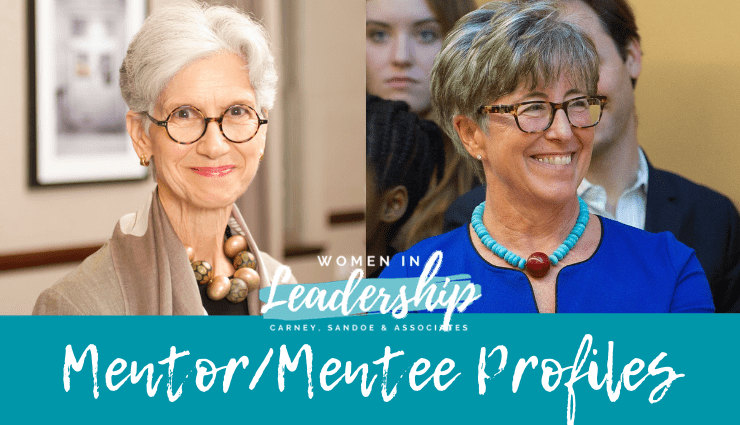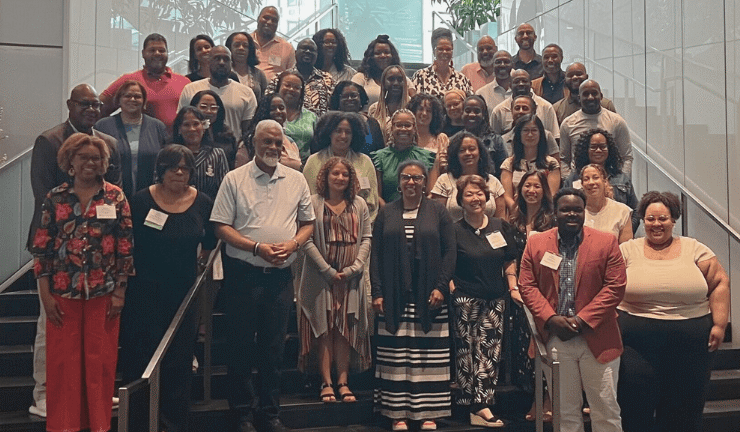Mentor/Mentee Profile: A Legacy of Women Leaders

This spring, CS&A is shining a spotlight on women in leadership. This piece is one of a series of stories about female leaders in independent schools, the importance of mentorship, and their professional journeys. Find the full series here.
CS&A is proud to have hosted the third-annual Women’s Institute on June 14 in Boston, an event designed to support women and their allies in the education community. Our Placement and Search Groups are dedicated to increasing the number of women in leadership roles as part of our commitment to diversity, equity, and inclusion.
Ask Barbara Landis Chase, now a Senior Consultant with Carney, Sandoe & Associates, what led her from being a teacher to heading a school and she’ll answer with one word, “Impatience.” As a young teacher with a B.A. from Brown University in history and a Masters of Liberal Arts from Johns Hopkins, Barbara wanted to lead the sort of changes in schools she felt they needed at the time. “I was impatient to make things happen. Changes that I knew should happen in schools for kids and faculty,” she says.
On the short list of changes:
- Greater awareness among school leaders of the needs of female educators with young children.
- School heads who consciously support female faculty who aspire to leadership roles.
- School leaders who clearly communicate the school’s highest ideals and inspire the faculty to support the strategic direction and resulting programmatic changes.
- Frank discussions about the racial and socioeconomic diversity of the students.
- Administrators and board members who create programs to serve the community beyond the enrolled students.
- More opportunities for faculty to develop their talents and expertise.
In 1980, at age 35, Barbara got her opportunity to lead such change when she was appointed head of The Bryn Mawr School in Baltimore. But to get to this top leadership position at such a young age, she’ll also tell you, she needed the help of a mentor: Hugh Madden, then head of The Wheeler School in Providence, Rhode Island, where Barbara had taught music, English, and history, and later served as director of admission.
“He was fabulous,” she says of Madden. “He believed in me, allowed me to work on committees and plan conferences. He invited me to attend board committee meetings —learn the leadership ropes. I am deeply grateful for that guidance and opportunity.”
It turns out that Madden also offered Barbara an excellent model for how to mentor other aspiring leaders. “Among the many lessons I learned from Hugh was the importance of focusing on trust and engagement with aspiring leaders,” she says. This lesson not only helped Barbara in her career, it offered her a process for helping other aspiring school leaders find their path.
When she got to Bryn Mawr, Barbara says, she was also fortunate enough to have a wonderful faculty and administration. Several of her mentees there would later go on to head schools themselves. One of them is Bodie Brizendine, now head of The Spence School in New York City.
Bodie was hired at Bryn Mawr in the mid-1980s as an English teacher. It was her first teaching job out of graduate school at Johns Hopkins. What she lacked in school experience, she made up for with immense energy, a love of teaching, and the skills of a gifted writer. “What impressed me from the start was her intelligence and ability to communicate,” Barbara says. “And kids just flocked to her. She had all the qualities you want in a teacher and all the qualities I would look for in an aspiring school leader — hard working, intellectually curious, kind, supportive of students and colleagues, and a great problem solver.”
When the position of director of admission opened up at Bryn Mawr, Barbara encouraged Bodie to take it. After that, the two became close colleagues on a very talented all-women leadership team. Baltimore was a competitive market for independent schools, so Bodie had to be smart about marketing the school and communicating its mission clearly and succinctly. She also had to be driven to succeed. She did all this and more — while continuing to teach.
Bodie left Bryn Mawr to work as the dean of students at San Francisco University High School in the early 1990s. But she returned a few years later as interim head of school at Bryn Mawr after Barbara left to be the first woman to head Phillips Academy in Massachusetts. Bodie says she was grateful for the opportunity to fill-in as head of school — as a means to improve her leadership skills and résumé.
“Even then,” Bodie says, “Barbara was supporting me. When I got to Bryn Mawr, I found notes from Barbara all over the head’s office. She even left a pair of loafers under the desk, which I jokingly told her I could never fill.”
The next year, Bodie was hired as the head of Marin Academy in San Rafael, California, a position she held from 1995 to 2007 when she made the move to her current position as head of The Spence School.
Even with the two of them heading separate schools, Barbara served as a mentor for Bodie, as an all-important sounding board in those early years of Bodie’s headship and as a friend in the later years. “Career-long relationships like this are so wonderful and valuable,” Bodie says, noting that they still stay in touch and get together whenever time allows.
For her part, Bodie says she was fortunate to have landed in Bryn Mawr straight out of graduate school. She didn’t know it at the time, but that first teaching job, working with, as she puts it, some of the best women educators in the country, set her up well for her own career in education.
“The administrative team included Barbara Chase, Lila Lohr, and Arlene Gibson,” Bodie notes. “All of them would go on to have remarkable careers as school heads and leaders in the broader education community. To have them together in one school at the same time is amazing. I didn’t know how lucky I was.”
In particular, Bodie acknowledges the steady support and wisdom she received from Barbara Chase, who would give her numerous opportunities to step up and lead — and learn about school leadership in the process. Describing Barbara’s mentoring as flawless, Bodie recalls times when Barbara would ask her to present at conferences or would take her to meetings with Baltimore institutions where she would connect with community leaders and learn from Barbara the art of creating a school narrative — the central, driving story of a school that includes its history and mission and generates excitement about new initiatives and the school’s future direction.
“This is what all great heads of school do,” Bodie says. “They create the narrative that elevates the mission and drives community support.”
But Bodie also talks more broadly about that remarkable administrative team of women educators at Bryn Mawr — how the group worked collectively. “At every meeting, we led with questions,” she says, “questions that were honored and that helped us understand better what we were doing well and what needed improvement. This is the kind of confidence and openness that Peggy McIntosh [Senior Research Associate at the Wellesley Centers for Women at Wellesley College and founder of the National SEED Project] talks about when talking about great leadership. I feel very blessed to have had this kind of orientation to leadership from the start.”
As head of Marin Academy, Bodie would take the wisdom of her mentors and combine it with her own energy and style to move the school forward in remarkable ways. In her 12 years as head of the school, she and her board raised more than $40 million, erected or renovated nine of the campus’s 12 buildings, and boosted the school’s reputation into, as one newspaper described it, “a top-notch (but still artsy) college prep with real soul.” She also continued the practice of teaching an English course and took opportunities to write about education for various publications — as a way to add to the collective wisdom about quality education and to keep the school’s name in the public eye.
At The Spence School, Bodie is applying the same lessons, building the school’s reputation as a diverse and topnotch institution that helps students — in this case, girls — develop agency and purposeful citizenship.
She is also trying to pay these lessons forward — reaching out to aspiring leaders in her school, giving them support, opportunity, and guidance. A number of her own mentees are now heading schools of their own, extending this remarkable network of women educators who support and guide each other as they do the hard work of leading and improving schools.
Like Barbara, Bodie makes it clear that mentoring future leaders is an essential part of headship. “Early in my career, I was invited to the table of women leaders in independent schools. This didn’t happen by accident,” she says. “Mentoring must be a priority — an obligation to the future of our schools and our profession.”
She and Barbara also point out that the practice of mentoring is also deeply fulfilling for the mentor, too.
“All of us think of ourselves as teachers first,” says Barbara. “So, what could be better than to teach others what we know about leadership, then watch them develop their skills and eventually lead schools? At the same time, you also learn so much from the people you have this relationship with. We talk about this as mentoring, but we are receiving so much in return.”








